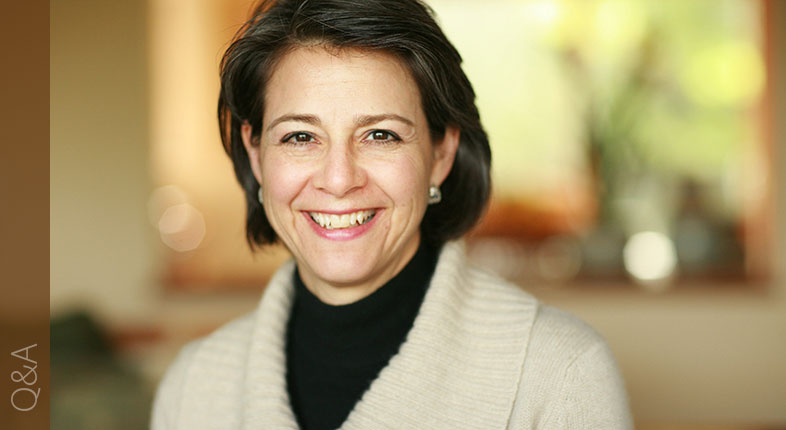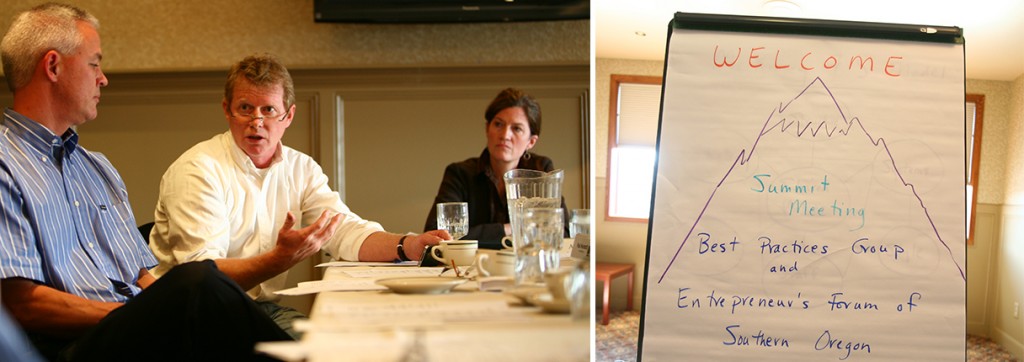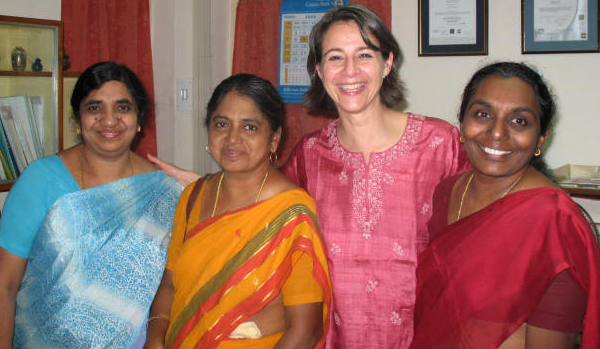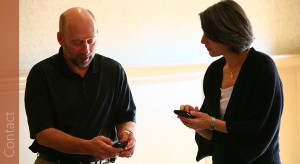
CANDOR. DISCERNMENT. INTEGRITY.
Interview conducted by Melissa L. Michaels
Q: How did you first become interested in management consulting?
A: Even before I went to business school, I had small business clients who needed help with business plans, organizational structure, and figuring out financing. People would find out that I had the ability to understand business dynamics—both in the marketplace and between individuals—and that I could either help them set clear priorities for action or establish operating principles for interaction.
I remember my first client. She had designed an interchangeable golf bag cover for women who wanted to change their bag to match their clothing. I helped her write a business plan to give to potential investors. Since then, I’ve worked with a wide range of businesses—from small start-up efforts to publically traded entities.

Q: What are some common problems faced by organizations you’ve worked with over the years, and how do you help resolve those problems?
A: Lack of clear direction or focus—I help organizations do strategic planning at the level and stage that is appropriate for them. Most organizations need to think carefully about the market space they are in and how they will create or build upon their competitive advantage. Some organizations that either are early stage or are reinventing themselves need what I call a “platform plan”—a plan that will put them in a position to be strategic in the future.
Dysfunctional team dynamics—If the leadership team doesn’t work well together, nothing gets done. Occasionally, I’ll have a client call for strategic planning only to find out that we have to do some work with the team before it makes sense to plan. I work with clients on strengthening their leadership team, enhancing the skill sets of team members, communicating effectively, and mediating conflicts. Robert Fritz says that structure determines behavior, and often the structure in an organization isn’t conducive to effective team behavior. In several cases, the platform plan I referred to earlier consisted of getting the right organizational or governance structure in place.
Haphazard feedback systems—People crave feedback about their work, yet it’s one of the most overlooked management responsibilities in organizations. Besides the obvious need to document performance expectations and results, an effective feedback system helps organizations identify high-potential people and weed out those who are ineffective. I help set up feedback systems such as a 360-degree review process and peer interviews that are followed up with individual development plans and executive coaching.
Developing high-potential executives—Not everyone enters a job with the precise skill set they need to become successful. What enabled you to be successful in one position may not be sufficient when you are promoted. I provide executive coaching for clients who want to sharpen already strong skills or build their capabilities in areas they will need as they grow with the organization.
No clear successor or leadership pipeline—I’m very sympathetic with business owners who are so absorbed in their business that they give very little thought to succession planning, and yet it’s essential to capture the value they have created. I help clients figure out what they really want in terms of an exit strategy and to engineer both an exit plan and a leadership transition plan that is palatable and achievable.
Naming the problem—Like in medicine, the presenting issue with a client isn’t always the underlying problem. I may receive a call for strategic planning work, only to find out the organization’s mission is stale and unclear, the board of directors is adrift and not very committed, or the reporting relationships in the organization are causing friction. Until some of the underlying issues are resolved, implementing a strategic plan is challenging at best. I use my skills to help organizations identify and deal with the real issues that prevent them from being their best.

Q: Have there been any particularly dramatic organizational transitions you’ve facilitated, perhaps guiding the institution from the brink of failure to triumphant recovery?
A: People often call consultants during times of change. It’s hard to think clearly and objectively when you are mired in your own business. I can give several examples in which I helped engineer dramatic change initiatives in organizations.
In one case, I helped two founder/owners of a company amiably “divorce.” They discovered they were giving mixed messages to their management team because each had different ideas about which direction the company should go. One left the company, while the other was free to exercise the leadership needed for the company to achieve its growth potential.
Succession planning is always challenging, especially for family-owned companies. No one wants to tell Dad it’s time for him to retire or to tell Aunt Sarah that her industry knowledge isn’t up to date. After many meetings to uncover the root of the problem in a third-generation family-owned company, I helped facilitate the transition from a family-dominated board to professional management, which allowed the company to attract the talent it needed to be successful.
Working with leadership teams so they function well together is hugely rewarding work. When a team brings diverse experience, skills, and personalities to the organization, they often need to learn how to make the most of the creative tension in the room. I’ve watched teams transform their discussions from unproductive advocacy and defensiveness to effective and generative dialogue.
Finally, I’ve coached several start-up ventures to growth and profitability, providing coaching to the CEO as well as resources for running the business.
Q: From your observations over the past two decades, what would you say are some of the hallmarks of a successful organization?
A: Leadership, Leadership, Leadership. Of course, leadership encompasses so many things: clarity of mission and future direction, healthy people management, strong financial management, compelling communication, experimentation, and innovation. Good leaders adapt their style and approach based both on the stage of the organization they are running and the nature of their followers. Jim Collins really is right when he makes the case for “getting the right people on the bus.” People—not legal entities—get things done.

Q: What are some common traits of successful leaders?
A: There must be 10,000 books written on this topic. One of my old favorites is John Gardner’s On Leadership. He lists about 15 attributes of leaders, many of which you would predict—like intelligence, courage, eagerness to accept responsibility, decisiveness, skill in dealing with and motivating people. Yet he also captures the more subtle—and crucial—qualities such as physical vitality, steadfastness, and adaptability. Jim Collins describes “humility and fierce resolve” as the hallmark of superior leaders. I would also add laser focus and the natural inclination or ability to put their organization’s mission above themselves to the list.
Of course, different circumstances demand different types of leaders. A start-up must have a highly responsive, action-oriented, impatient, adaptable, and almost compulsive leader. A mature organization requires a reflective leader who also has a considerable amount of drive. The leader needs to be self-aware and aware of their many stakeholders. They need a good sense of timing and the ability to communicate effectively through various media. Finally, they need a leader who constantly renews and reinvigorates the organization.

Q: What unique issues do southern Oregon businesses face, and how do you recommend coping with those issues?
A: Isolation: Despite our location on the I-5 corridor, I think isolation is a major problem for southern Oregon businesses. I encourage my clients to join their trade associations, attend continuing education conferences, find sources for professional development, read widely, and look for inspiration from best practices in many places. One of the reasons I think my CEO peer group has been together for so many years is that it provides a regular forum for business owners to learn from each other and share ideas across industries.
Capital: Access to capital has been a more recent challenge following the banking crisis. It’s not necessarily unique to southern Oregon, but in areas like this, entrepreneurs don’t have much access to venture capital funds or angel networks. That’s why I’ve been active for the past few years with the Jefferson Grapevine. It provides a place to connect innovative new businesses with private investors. I’ve been very encouraged to see the Southern Oregon Angel Network start recently. We’re also fortunate to have several strong community banks whose niche is small to mid-sized local businesses.
Talent: I’m listing this as a unique problem only because it is a perceived issue among many employers. Because the talent pool is thinner here than in a major metro area, many businesses “grow their own” in the Rogue Valley, which provides opportunity to people who live here. Southern Oregon University and Oregon Institute of Technology in Klamath Falls produce excellent graduates, and businesses here recruit heavily from those institutions. I’ve also seen some organizations successfully bring in talent from outside the area, but they have to make sure the cultural fit is strong.

Q: You chair the Entrepreneur’s Forum of Southern Oregon each month. What was the inspiration behind creating that group?
A: When I first visited a CEO peer group in Portland, I was so excited that I called my former boss in Washington, D.C., to encourage her to join one there. The Entrepreneur’s Forum is a peer group of CEOs and presidents of non-competing companies who meet monthly in a confidential forum to discuss business issues, share resources, and continue their professional development as leaders. The group uses a three-part model: a) monthly peer group meetings; b) monthly executive coaching sessions with me; and c) quarterly resource speakers who bring new ideas and perspectives to the group. We share best practices across industries, which leads to rich discussions and cross-fertilization of ideas. It’s a model that works beautifully and adds immeasurable value to the companies who participate.
Q: You hold an MBA from Stanford Graduate School of Business and a master’s in theological studies (MTS) from Harvard Divinity School. This gives you a unique perspective on business ethics as well as the values of honesty, integrity, and transparency. Let’s say you were charged with helping a formerly tainted corporation (take Enron as an example) completely reinvent itself from the core, not just superficially but at a deeper institutional level. How would you approach a challenge like that?
A: I would start with the leader and the leadership team. Everything flows downhill. In reinventing a corrupt organization, the first thing you have to do is re-establish trust, and you’ll only do that if the leaders are sincere, authentic, consistent, and transparent in all they say and do. Heck, Enron had perfectly good stated “values,” but their actions were not aligned with their words.
Q: Tell me about the 800-member Harvard/MIT Women and International Development Group you helped lead while in graduate school.
A: A group of women who were professionals and academics in international development, most of whom were from developing countries, started an organization to bring women’s issues in development to the forefront of the dialogue on the Harvard and MIT campuses. This was during the UN Decade for Women. We brought in speakers, published a series of white papers, and encouraged research on women’s role in economic development.

Q: You earned your undergraduate degree in English literature from Oberlin College. What kind of activities did you engage in as an Oberlin Shansi fellow to Madurai, India?
A: I was in India in the early 1980s and taught conversational English and Western music to college students. I studied the Tamil language and Carnatic music. Mostly, my role was as a goodwill ambassador since at that time, Shansi was still re-establishing its relationship with Indian universities. I’m a long-term Indiaphile and have been back several times since. My interest in international development started during that trip and has continued since.

Q: In addition to your consulting work, you also teach. Can you talk about the various courses you teach both in the U.S. and at the Universidad de Guanajuato in Mexico?
A: I teach Organizational Leadership in Southern Oregon University’s Master in Management program both in the U.S. and in Mexico. I love teaching that class because it gives me an excuse to stay current with the literature on organizational leadership and provides a means of passing on real-life application of the material to students. I learn about their leadership dilemmas, and they learn about mine.
I also teach Presentation Skills for the Professional. I developed this class in response to a need I saw both in the Leadership class and in the professional world. Most of my clients should take this class! We record every presentation the students give in front of the class so they can watch themselves and learn. The camera never lies. It’s the most painful, helpful thing I’ve ever done to improve my public speaking. It’s also fun and engaging—by then end of class, everyone is rooting for each other.

Q: You’re a soprano in the Southern Oregon Repertory Singers. Has singing been something you’ve practiced all of your life, and what lessons can you take from that realm and apply to organizational leadership?
A: I’ve been singing since I was 10 and plan to do so as long as I have a voice. Most of my experience is in classical choral music, and there are myriad lessons that apply to the business world. I’ll come back to the theme again—the leader makes it all happen. Great conductors produce marvelous music even with mediocre singers; lousy conductors can’t make music with the best. In my music, I practice being a good follower—I come prepared, give undivided attention, listen very carefully, and deliver a performance for others to enjoy.

Q: What has been one of the most rewarding moments of your career?
A: Getting a thank-you note from the CEO of a successful company that had been struggling when I worked with them. I hadn’t heard from him in two or three years, and out of the blue, I received a heartfelt note telling me how much he had appreciated my counsel and that of his CEO group. I was touched that he took the time and very gratified to know that I had been able to help.










